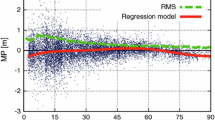Abstract
Similar to the antenna phase center corrections for phase measurements, group delay variations (GDV) of satellite and receiving GNSS antennas affect code pseudorange measurements. They are frequency-dependent and vary with the direction of signal transmission and reception. We present the first GDV estimates for all five Galileo and three GLONASS frequency bands based on terrestrial observations. As compared to GPS, the orbit properties of Galileo and GLONASS simplify this approach, because a single reference station can observe each Galileo and GLONASS satellite in its entire elevation angle range during one orbit repeat period. The homogenous results of three receiver antenna models for identical satellite types and a comparison to GPS Block IIF indicate mainly receiver antenna-specific GDV. They amount to 35 and 28 cm peak-to-peak for Galileo and GLONASS frequency bands E1 and G1, respectively, depending on the receiver antenna type. We show their effect on linear combinations where the code observable is used for precise applications and validate our GDV estimations by improving the height component in single-frequency precise point positioning.









Similar content being viewed by others
References
Arenas S, Monjas F, Montesano A, Montesano C, Mangenot C, Salghetti L (2011) Performances of GALILEO system navigation antenna for global positioning. In: Proceedings of 5th European conference on antennas propagation, EUCAP. pp 1018–1022
Beer S, Wanninger L (2018) Temporal stability of GPS transmitter group delay variations. Sensors 18:1744. https://doi.org/10.3390/s18061744
Dow JM, Neilan RE, Rizos C (2009) The international GNSS service in a changing landscape of global navigation satellite systems. J Geod 83(3–4):191–198. https://doi.org/10.1007/s00190-008-0300-3
Guo F, Li X, Liu W (2016) Mitigating BeiDou satellite-induced code bias: taking into account the stochastic model of corrections. Sensors 16:909. https://doi.org/10.3390/s16060909
Haines BJ, Bar-Sever YE, Bertiger WI, Desai SD, Harvey N, Sibois AE, Weiss JP (2015) Realizing a terrestrial reference frame using the global positioning system. J Geophys Res Solid Earth 120(8):5911–5939. https://doi.org/10.1002/2015JB012225
Hatch R (1982) The synergism of GPS code and carrier measurements. In: Proceedings of 3rd international geodetic symposium on satellite doppler positioning. Las Cruses, pp 1213–1231
Hauschild A (2017) Combinations of observations. In: Teunissen PJG, Montenbruck O (eds) Springer handbook of global navigation satellite systems. Springer, New York, pp 583–604
Hauschild A, Montenbruck O (2015) The effect of correlator and front-end design on GNSS Pseudorange biases for geodetic receivers. In: Proceedings of ION GNSS+2015, Institute of Navigation, Tampa, pp 2835–2844
Hauschild A, Montenbruck O (2016) A study on the dependency of GNSS pseudorange biases on correlator spacing. GPS Solut 20(2):159–171. https://doi.org/10.1007/s10291-014-0426-0
Hauschild A, Montenbruck O, Sleewaegen J-M, Huisman L, Teunissen PJG (2012a) Characterization of compass M-1 signals. GPS Solut 16(1):117–126. https://doi.org/10.1007/s10291-011-0210-3
Hauschild A, Montenbruck O, Thoelert S, Erker S, Meurer M, Ashjaee J (2012b) A multi-technique approach for characterizing the SVN49 signal anomaly, part 1: receiver tracking and IQ constellation. GPS Solut 16(1):19–28. https://doi.org/10.1007/s10291-011-0203-2
ILRS (2014) SLR Center-of-Mass (CoM) measurement correction information. https://ilrs.cddis.eosdis.nasa.gov/missions/spacecraft_parameters/center_of_mass.html. Accessed 15 Aug 2019
IS-GPS-200 (2018) Global positioning systems directorate, systems engineering and integration, interface specification IS-GPS-200, Revision Journal
Kersten T, Schön S (2017) GPS code phase variations (CPV) for GNSS receiver antennas and their effect on geodetic parameters and ambiguity resolution. J Geod 91:579–596. https://doi.org/10.1007/s00190-016-0984-8
Melbourne WG (1985) The case for ranging in GPS based geodetic systems. In: Proceedings of 1st international symposium on precise positioning with the global positioning system. Rockville, pp 373–386
Montenbruck O, Hauschild A, Steigenberger P (2014) Differential code bias estimation using multi-GNSS observations and global ionosphere maps. Navigation 61:191–201. https://doi.org/10.1002/navi.64
Okerson G, Ross J, Tetewsky A, Soltz A, Anszperger J, Smith SR Jr (2016) Inter-signal correction sensitivity analysis: aperture-dependent delays induced by antenna anisotropy in modernized GPS dual-frequency navigation. Inside GNSS 11(3):44–53
Rocken C, Meertens C (1992) UNAVCO receiver tests. UNAVCO Memo 8
Rothacher M (2001) Comparison of absolute and relative antenna phase center variations. GPS Solut 4(4):55–60. https://doi.org/10.1007/PL00012867
Tian Y, Sui L, Xiao G, Zhao D, Tian Y (2019) Analysis of Galileo/BDS/GPS signals and RTK performance. GPS Solut. https://doi.org/10.1007/s10291-019-0831-5
Wanninger L, Beer S (2015) BeiDou satellite-induced code pseudorange variations: diagnosis and therapy. GPS Solut 19(4):639–648. https://doi.org/10.1007/s10291-014-0423-3
Wanninger L, Sumaya H, Beer S (2017) Group delay variations of GPS transmitting and receiving antennas. J Geod 91(9):1099–1116. https://doi.org/10.1007/s00190-017-1012-3
Wu JT, Wu SC, Hajj GA, Bertiger WI, Lichten SM (1993) Effects of antenna orientation on GPS carrier phase. Manuscr Geod 18(2):91–98
Wübbena G (1985) Software developments for geodetic positioning with GPS using TI 4100 code and carrier measurements. In: Proceedings of 1st international symposium on precise positioning with the global positioning system. Rockville, pp 403–412
Yang W, Tong H, Pan L, Xu D, Guo W, Yang J (2016) Analysis and correction of BDS code multipath bias. In: Sun J, Liu J, Fan S, Wang F (eds) China satellite navigation conference (CSNC) 2016 proceedings, vol III. Springer, Singapore, pp 503–513
Zehentner N (2016) Kinematic orbit positioning applying the raw observation approach to observe time variable gravity. Dissertation, Graz University of Technology
Zhou R, Hu Z, Zhao Q, Li P, Wang W, He C, Cai C, Pan Z (2018) Elevation-dependent pseudorange variation characteristics analysis for the new-generation BeiDou satellite navigation system. GPS Solut 22:60. https://doi.org/10.1007/s10291-018-0726-x
Zou X, Li Z, Li M, Tang W, Deng C, Chen L, Wang C, Shi C (2017) Modeling BDS pseudorange variations and models assessment. GPS Solut 21:1661–1668. https://doi.org/10.1007/s10291-017-0645-2
Acknowledgements
This research has been supported by the German Research Foundation (DFG) under grant WA 868/8-1. All observation data used in this study were made available free of charge by UNAVCO, Geoscience Australia, and the International GNSS Service (IGS). The authors are grateful to these institutions and the station operators for their valuable services.
Author information
Authors and Affiliations
Corresponding author
Additional information
Publisher's Note
Springer Nature remains neutral with regard to jurisdictional claims in published maps and institutional affiliations.
Rights and permissions
About this article
Cite this article
Beer, S., Wanninger, L. & Heßelbarth, A. Galileo and GLONASS group delay variations. GPS Solut 24, 23 (2020). https://doi.org/10.1007/s10291-019-0939-7
Received:
Accepted:
Published:
DOI: https://doi.org/10.1007/s10291-019-0939-7




